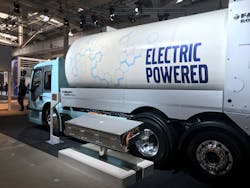It was impossible to walk through miles (that’s no exaggeration) of displays at the 2018 IAA Commercial Vehicles show without picking up on a common theme among almost all – electrify, automate, and connect.
Whether it was flashy concept trucks or slick new models from the major truck groups or inventive demonstrations of advanced technology components, everyone seemed to be on the same page when it comes to the future of trucking.
And that really wasn’t a surprise. At the last IAA in 2016 the message echoing around the show’s 14 pavilions was “connect, automate, and electrify.” So the message hasn’t changed in two years, but the emphasis has. Not only has the drumbeat gotten louder, but electric powertrains and connectivity have swapped places on that list.
Electric CVs have clearly moved to the front of the line both in public perception and in R&D activity. Fired up by high-visibility media campaigns launched by startups like Nikola Motors, public enthusiasm is based more on wishful thinking than realistic expectations. But judging by activity at this year’s IAA, truck makers have embraced electrification in a more practical, if no less enthusiastic way in the last few years.
First, they see the writing on the wall. Ever increasing urbanization on a global scale requires solutions to congestion, air quality and other quality of life issues. Trucks are an obvious target. Moving a sizeable number of them to electric delivers zero emissions, lower noise and an easier path to congestion-relieving autonomous operations.
Second, the show was solid evidence that the technology to enable electric EVs has advanced quickly. Better batteries, integrated e-motor and hybrid packages, encouraging activity on fuel cells, and new vehicle configurations designed specifically to take advantage of e-powertrain characteristics all were on display.
Also virtually every OEM was talking about their e-truck strategies. Most have light-duty vans ready for production -- vehicles that require only limited range, relatively low-load capacity and return daily to a home base for recharging. A bit further out, medium-duty e-trucks with similar operating characteristics are well along in the development cycle. And heavy-duty trucks for urban distribution and even long-haul were part of the discussion.
The third reason all the e-truck activity is a business one. At least one supplier forecasts that 25% of all new CV sales will be electric trucks by 2030, and that number should be over 30% in China, now the world’s largest truck market. It’s obvious now that in the right applications, e-trucks make economic sense for truck users.
But don’t mistake all this show activity for an onslaught of production ready e-trucks in the next year or so. Every OEM at the show made the point both with their models on display and in their discussions with the press that diesel will remain the dominant answer for trucks for many years. It’s just too efficient, clean, durable and reliable to be displaced except in specific applications where electric has the advantage. All the same, based on the IAA evidence electric vehicles are coming soon, and most likely they will come to commercial vehicles first.
It was much the same story for automation, which has become the preferred term over autonomous. While driverless trucks may be the Holy Grail for some, no one at IAA was ready to put a timeframe on such a radical step.
Instead a variety of systems – some safety related, others meant to boost productivity – showed various levels of automation indicating an evolutionary path to that end. Platooning, automated emergency braking, lane-keeping assistance, pedestrian protection and other advanced driver assistance systems all represent “a stepping stone to autonomous trucks,” as one exhibitor put it. And those systems are already here or just about to be put into play.
As for connectivity, that’s fallen to the end of the list because in essence it’s already here. Modern trucks of all sizes are closely connected to fleets, manufacturers and other interested parties on a continuous basis. In fact it’s the widespread proliferation of low-cost, ubiquitous connectivity for CVs that’s made possible the recent advances in electric power and automation.
The one remaining piece of the connectivity puzzle is a standardized way to connect all vehicles with fast, real-time communications. And again looking to the future, exhibitors at IAA demonstrated how truck users will benefit from almost completed efforts to finalize and exploit vehicle-to-vehicle (V2V) standards.
There’s a simple reason the exhibitors at IAA this year were so focused on electric powertrains, automation and connectivity – they see a solid total-cost-of-ownership (TCO) benefits in all three for truck users. And truck users are, if nothing else, supremely practical when it comes to investing in anything that might give them a cost advantage. That’s why a major suppliers like Bosch reported at the show that i’s CV sales are growing twice as fast as its automobile business, and ZF announced that it is investing 12 billion Euros in automation and electrification. And why every truck maker gave pride of place in their displays to vehicles that showed off investments in those areas.
Based on all the evidence on display at IAA this year, that three-legged stool of electric, automate and connect is clearly the foundation of trucking's future.




